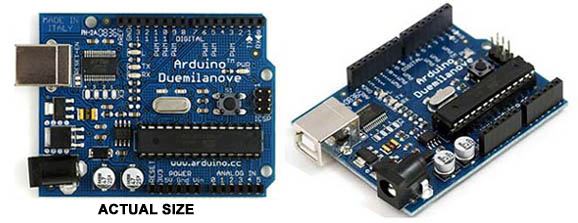Turning Your Static Pieces Into DYNAMIC, INTERACTIVE Pieces
THIS is a "micro controller" aka a micro computer - specifically an Arduino Duemilanove ("2009" in Italian). You can pick one up for about $ 30 USD from a half dozen or so online sources. With one of these things you can add light, sound and movement to your next piece AND make DO things - AND be interactive - without any physical contact.

It's a programmable micro-computer with a power plug to run it off a transofrmer or battery, a USB plug for communication with your desk top or laptop computer as well as pins to plug in a Serial-TTL cable. With 6 Analog and 13 Digital input / output pins, six of the Digital pins being Pulse Width Modulated (PWM), along with 3 & 5 volt power pins and ground pins to which you can connect components - With it YOU can control motors, stepper motors, servos, lights, speakers, buzzers, relays , all sorts of sensors / detectors and Stuff That Does Stuff. Basically it's a Brain to which YOU can add not only Senses (hearing, touch and sight), but also a Voice (buzzers and speakers you can make sing or tal k), Muscles (servos, motors, stepper motors and relays) AND Light (LEDs and RGB LEDs) .
Because these are Open Source devices (no one has proprietary rights to the concept or its applications) and uses uses Open Source "C" programming language, there's no MIcroSoft or Intel controlling things - and making tons of money by doing so. Most electronic components needed to Do Stuff are readily available at places like Radio Shack and scores of On Line Stores. So it won't cost you an arm and a leg to get into using a Micro Controller. With plenty of turorials and videos on how to use them available on the internet, you can be up and playing with one in no time. Like the early HP Pocket Calculator, these things are Solutions Looking For Problems To Solve. As you learn the basics of using them - you'll come up with all kinds of applications - YOU can actually do. And once you've played with them a bit - all sorts of things you can do with them will pop into your head.
Overview and an example applications
OK - show me some examples of this idea applied to turning
Looks like a lot of little wires to keep track of - and I'm not a computer programmer
One works. Two each work. Two work together. But three . . .